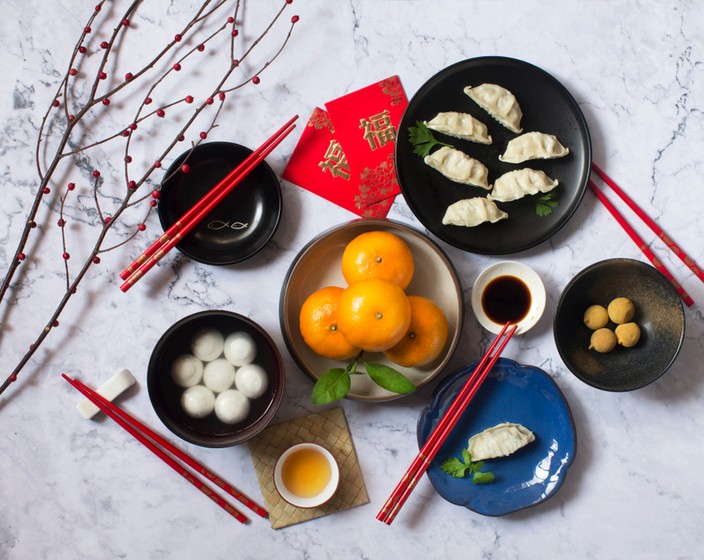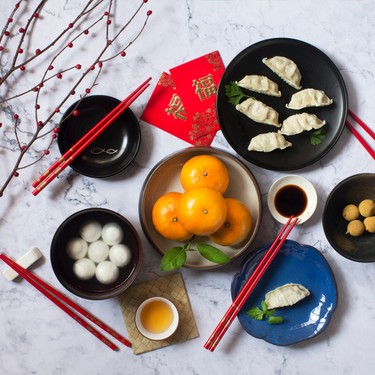8 Traditional Chinese New Year Dishes to Welcome the Tiger




Chinese New Year is about to begin. This year we welcome the year of Water Tiger that officially starts on the 1st of February, with the celebrations going on for 16 more days.
Also known as Lunar New Year or Spring Festival, this holiday is celebrated by more than 2 billion people worldwide. And the food is once again in the center of this beautiful tradition.
Traditional Chinese New Year foods are delicious and carry a deeper meaning behind every dish, making sure we bring luck and prosperity into our homes.
In 2022 we got our eye on the tiger, Water Tiger, more precisely. Let’s please the symbol of the coming Lunar year and welcome him into our homes, all while enjoying some delicious traditional Chinese New Year dishes.
Here is our selection of the best recipes to make for the Spring Festival and some interesting traditional meanings behind them.
Steamed fish is a must-have dish on the Chinese New Year dinner menu. The Chinese character for fish ‘yu’ 鱼 sounds like the character 余 meaning surplus or prosperity.
It’s a common belief that having fish on the festive dinner table will bring more “surplus’ or prosperity in the coming year. And your choice of fish can further secure that promise. So you should make your choices based on traditional auspicious homophones:
Chinese Mud Carp
Chinese mud carp or 鲤鱼 li yu is homophonic to another li 礼 that means “gifts”, so making steamed mud carp will only double your chances of a prosperous year.
Catfish
The first character for catfish, 鲶鱼 nian yu, sounds similar to 年 nian, which means “year”. So together, they will bring you a “yearly surplus.”
Crucian Carp
Crucian carp is the number one choice of fish for the Chinese New Year dinner table. The first character for carp, 鲫鱼 ji yu, is homophonic to 吉 ji “good luck.” Putting these two together means you will have prosperity and good luck in the new year. It’s a win-win.
No matter what kind of fish you choose to make these, we can guarantee it will not disappoint. Both recipes are super easy to make and delicious. Please both the water tiger and your taste buds!
Traditional Chinese dumplings are made to look like ‘sycee,’ or ‘yuan bao,’ a type of gold or silver ingot currency used in imperial China. They are a traditional popular “lucky food” for the Chinese New Year table.
According to a well-known legend, the more dumplings you can eat over Lunar New Year (and believe us, you can eat a lot in SIXTEEN DAYS), the more money you can make in the coming year.
No matter what dumpling filling you choose (and you can pretty much make a different batch for each day), make sure you fold them to resemble the traditional ingots. And getting some guaranteed luck on top of that is just an extra win.
The most traditional dumpling filling of minced pork and chives. You can make these in under 30 minutes. And they are so delicious, Chinese New Year will not be your only reason to make these bad boys.
Lemongrass and chicken filling make these dumplings incredibly tender and juicy.
These dumplings are meat-free and full of healthy ingredients like tofu and various greens.
One more vegetarian option for dumpling lovers - these mushroom dumplings are delicious.
If you think that noodles are a bland everyday dish, there’s something special about noodles traditionally eaten to celebrate New Year.
Traditional noodles for New Year (or birthday) celebrations are called chang shou mian 长寿面, where the first two characters mean ‘longevity’ and the third one means ‘noodles’.
The trick here is to make your noodles as long as you possibly can. And then you are free to cook them however you like - make classic chow mein noodles, or Szechuan-style beef noodle soup. The main goal is to make your noodles as long as possible.
You can take this recipe and use your noodles in any of your favorite dishes.
Spring rolls or 春卷 chun juan, get their name from the tradition of eating them during the Spring Festival.
They are a particularly popular Cantonese dish, traditionally filled with pork, shrimp, and a mix of vegetables, deep-fried to crunchy golden perfection. One more dish you are undoubtedly familiar with and will make repeatedly.
Steamed rice flour cakes or 发糕 fa gao are classics to enjoy during the Chinese New Year. And once again, they carry an auspicious meaning in their name. ‘Fa gao” translates to ‘prosperity cake.’
These mildly sweet rice cakes are steamed in bamboo baskets and are known for their split tops. The more sections (splits on top) you get on the cake, the luckier you will be in the New Year.
Chinese New Year is all about bringing the family together. Sweet rice balls, or 汤圆 tang yuan, are associated with togetherness and reunion. Many people enjoy this glutinous rice dessert during the Lantern Festival, but they are a typical festive dish for Chinese New Year as well.
Tangerines and oranges are known as ‘good fortune fruit’ commonly eaten during Chinese New Year celebrations. The Chinese character for ‘orange’ (橙 cheng) is a homophone for ‘success,’ and the character for tangerine (桔 ju) contains ‘luck’ as its main component.
It’s always nice to have these citrus fruits on the dinner table or make a dish with tangerines or oranges as the main ingredient.
Make any one of these citrusy delicious desserts for Lunar New Year Celebrations.
Eight treasures rice pudding represents luck, wellness, and prosperity. Eight is a lucky number commonly associated with wealth, and this traditional dish contains eight of the good luck ‘treasures’: various nuts, seeds, raisins, plums, and rice. It’s festive, colorful, and simply delicious!